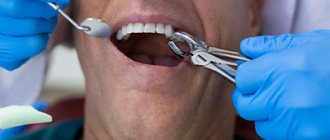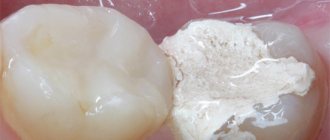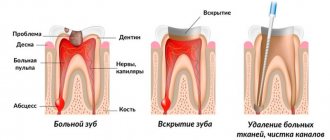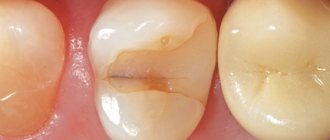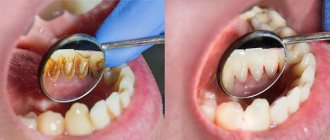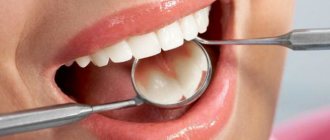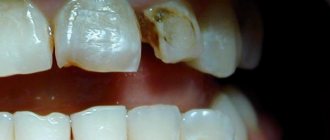Questions and answers on: tooth hurts under a filling
The most common questions patients ask after tooth filling concern pain.
- Question : “A month ago, I had a tooth healed using paste to kill the nerve and installing a temporary filling, but it hurts when pressed. Also, the gums on the cheek side were swollen. After the temporary filling fell out, I did not install a new one. What to do? Is it related to the root or the nerves?” Answer : “Most likely, the periosteum became inflamed because the canals were not treated in time. It was necessary to treat them and put a permanent filling. In your case, the tooth needs to be removed, but if you consult a doctor urgently, there is a small chance of saving it.”
- Question : “Can a tooth hurt after filling? It’s been 2 hours since the filling was placed, but I feel a little pain.” Answer : “Mild pain in a filled tooth is a natural physiological reaction to surgical intervention in the dental cavity. Periodic painful sensations may be felt for 2 months until complete healing. They will pass unless the pain becomes more severe and increasing.”
- Question : “Yesterday we got a filling, but the tooth still hurts. A small rash and itching appeared near him. I can’t stand it any longer, what should I do?” Answer : “You need to see a doctor to replace the filling. You have developed an allergic reaction to it. This is quite a rare occurrence."
- Question : “A week ago I was treated for caries and a filling was placed at the 6th unit below. But the tooth did not stop hurting. It especially bothers me at night; I can’t sleep due to the throbbing pain. Should a tooth hurt after filling?” Answer : “Most likely, the dentist treated you for deep caries due to periodontitis or chronic pulpitis and made a mistake, guided only by a visual examination of the oral cavity. In any case, it was necessary to take an x-ray of the tooth affected by caries. We urgently need to remove the filling and treat the canals.”
- Question : “2 weeks ago a permanent filling was placed without removing the nerve, but it still hurts me to chew. In addition, the tooth reacts to cold and hot food and at times there is aching pain.” Answer : “Such symptoms may indicate the development of chronic pulpitis or the development of an abscess inside the tooth.”
If various pains appear in the tooth after the filling procedure, then the only recommendation is to contact a qualified specialist. After all, the reasons can be completely different.
Causes of pain under a filling
There are several reasons why a tooth under a filling may hurt:
- Incomplete pulp removal. This can happen if an x-ray was not taken before treating the tooth. A tooth may have its own structural features: thin winding canals, the presence of additional canals. Without radiography, it is impossible to carry out high-quality canal treatment. Remaining areas of pulp will certainly lead to pain.
- Burn of dental tissues. During tooth preparation, the dental bur heats up. If the dentist does not cool the tissue frequently, you can get burned.
- Incorrect technique for drying the prepared cavity. Violation of the technique leads to insufficient adhesion of the filling to the dental cavity. Bacteria penetrate inside and cause inflammation.
- Entry of a foreign body into the root canal. This could be a piece of a canal cleaning tool or particles of dentin (hard tooth tissue) formed during drilling.
- High filling. When a tooth comes into contact with an opposing tooth on the opposite jaw, pain occurs due to too much pressure.
These reasons apply to cases where a tooth that was filled very recently hurts.
Sometimes patients go to the dentist complaining of pain in teeth that were filled several months or years ago. Probable reasons for this:
- Secondary caries. It develops due to the penetration of bacteria under the old filling due to its shrinkage or mechanical damage. A hidden inflammatory process begins, affecting the nerve (if it has not been removed before and the filling was installed due to caries).
- Periodontitis. If the nerve has already been removed previously, then it is not the cause of the pain. It is possible that periodontitis has developed - inflammation of the periodontium (the connective tissue surrounding the tooth). Periodontitis occurs due to the penetration of bacteria into the periodontal ligaments or mechanical trauma to the tooth (bruise, blow, sharp biting).
In all the described cases, one cannot hope that the pain will go away on its own. If the inflammatory process has already begun, it will spread more and more. You can lose a tooth due to neglect of your health
Tooth hurts after nerve removal and filling
Only a dentist after an examination will help you figure out why a tooth hurts after removing a nerve and filling its canals. Treating teeth on your own without a diagnosis is highly discouraged.
In dental practice, the procedure for treating tooth canals by removing a nerve is a rather complex manipulation. Cases of medical error are common. They are fraught with various complications, in which the filled tooth continues to hurt.
The main reason why a “dead tooth” (without a nerve) is bothersome is:
- removal of the filling material beyond the apex of the tooth - this occurs due to incorrect definition
- working tooth length;
- the doctor filled the canal incorrectly;
- a tool broke off in the canal;
- root perforation of the tooth;
- If your tooth aches, you may be allergic to the filling material.
It is worth considering that a tooth under a filling can hurt even without a nerve. After all, during the extraction procedure, only a small part of it is removed from the root canal, which branches off from the main nerve trunk. In addition, when removing and filling canals, dental tissues are damaged. When an anesthetic is applied to a tooth, pain is not felt; it begins to be felt after the anesthesia wears off. Such painful sensations are called post-filling.
After removal of a nerve, neighboring teeth can often be bothered, but it seems as if it is the treated tooth that is hurting. An experienced doctor will examine the dentition to identify and eliminate this problem. However, it is worth sounding the alarm when the nerve has been removed for a long time, and the tooth continues to hurt - this symptom may signal the development of chronic pulpitis or periodontitis.
Nerve removal in dentistry
Is it painful to remove a nerve?
Not so long ago, the prospect of undergoing a procedure to remove a nerve filled patients with horror, as it was more reminiscent of medieval torture than medical manipulation.
A lot has changed in modern dentistry, and, nevertheless, the question “whether it hurts or not to remove a nerve” still worries patients who have heard a lot of scary stories from older people. Fortunately, the local anesthesia used in modern dental offices makes these fears unfounded. The maximum that a patient will have to face today is mild psychological discomfort. Removal of the nerve in a baby tooth is often performed in children under general anesthesia. By the way, this type of anesthesia can also be applied to an adult patient upon his persistent request or in the presence of certain medical indications.
So, removing a nerve in modern dentistry is no more terrible a procedure than a regular filling.
Tooth nerve removal and canal cleaning
Previously, a similar procedure was carried out with arsenic, which was accompanied by very unpleasant sensations. Dentistry has come a long way now. The use of modern drugs reduces the risk of complications and makes the procedure painless.
First of all, patients are concerned about whether it is painful or not to remove the nerve and how the removal itself occurs, as this procedure is scientifically called.
Removal of a nerve in dentistry is performed under anesthesia, so the patient feels virtually no pain.
Removing the nerve is called depulpation. If the damage is in the front tooth, the procedure is even more complicated. Removal is carried out as carefully as possible, since the front teeth perform an aesthetic function. When removing a nerve, it is not necessary to remove the tooth itself. If depulpation is carried out correctly, the tooth will last for many years.
When a nerve is removed from a tooth, the consequences are often unpredictable. However, the professionalism of the doctor and the use of modern equipment will reduce the likelihood of complications to a minimum.
Removal of a nerve in a baby tooth
For a long time there was a belief that there are no nerves in baby teeth, which is why they almost never hurt in children. However, this is a myth; baby teeth also have nerves. Children's teeth rarely hurt because they quickly decay and are replaced by molars, so pain does not have time to arise.
The procedure for removing the nerve of a baby tooth is carried out in several stages:
- Initial examination, identification of a diseased tooth;
- Conversation with parents, discussion of treatment and removal options, use of anesthesia;
- Tooth opening;
- Cleaning and sterilization of canals;
- Installation of a seal;
- Checking the quality of work using an x-ray.
Indications for nerve removal are the same conditions as in an adult: pulpitis, deep caries, trauma, etc. Sometimes a small child cannot sit still, screams and gets nervous. In this case, removal is impossible without the use of anesthesia. There is a video on the Internet showing the procedure.
Depulpation is carried out very carefully, since there is a high risk of damage to the molar tooth germ.
Tooth hurts after root canal filling
Dental clinic patients are often concerned about the question of why their tooth hurts after inserting filling material into the tooth canal after removal of the nerve. Since any intervention in the body has its consequences, toothache is an “echo” of the filling procedure.
The most common reasons for a tooth to ache after root canal filling are:
- burns and overdrying of dentin;
- allergic reaction to filling material;
- depressurization of the seal;
- change in bite;
- exposure to polymerization lamps;
- shrinkage of the filling.
After the procedure, the dentist usually advises you on how long the tooth under the filling hurts. However, if you feel increasing pain in a filled tooth for more than 2 weeks, you should urgently consult a doctor. Such pain can occur when an instrument breaks off in the canal, root perforation, or improper treatment of pulpitis.
Standards for quality depulping and guarantees
Effectiveness depends on the physician's adherence to the endodontic treatment protocol. Our Center has developed Unified Quality Standards that all specialists follow.
Endodontic dental treatment in our Center is carried out in the LifeTime Warranty format. We have eliminated the risk of re-infection of the canals at each stage:
- Isolation of the working area with a rubber dam Protects against the entry of saliva with bacteria that provoke inflammation. In our Center it is mandatory and included in the price.
- Measuring the length of the canal using an apex locator is necessary to fill the canal with material along its entire length. Eliminates going beyond the top of the tooth and the possibility of underfilling.
- Abundant antiseptic treatment Continuous treatment with sodium hypochlorite solution ensures sterility of the canal and eliminates the risk of infection.
- High-quality canal filling Dental microscope and 3D filling technologies make it possible to avoid voids in canals with pathogenic microorganisms.
- Mandatory X-ray control during the process. Important for processing and filling canals, taking into account their configuration. The doctor controls the filling of all bends and branches of the canals.
- Hermetic restoration of tooth shape. Guarantee of sterility of sealed canals. The reliable design blocks the access of infection from the oral cavity.
But modern gadgets and technologies are useless if they are in the hands of an inexperienced dentist. Manual skills and the ability to establish contact with the patient are an important condition for successful treatment.
Our Center employs highly qualified general practitioners and endodontists, who are among the TOP 10 general practitioners in Moscow in the categories “Endodontics” and “Dental Restoration.”
